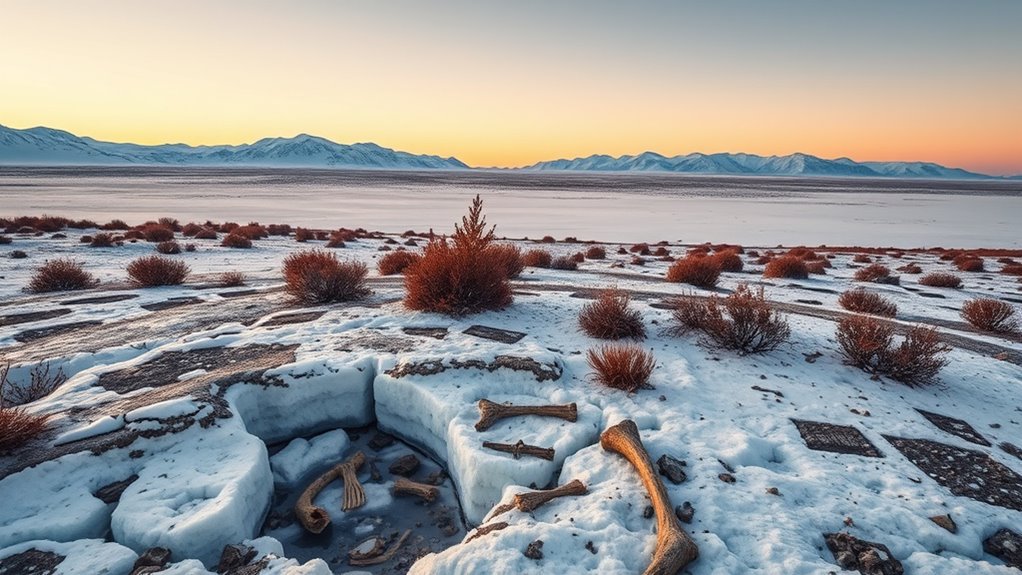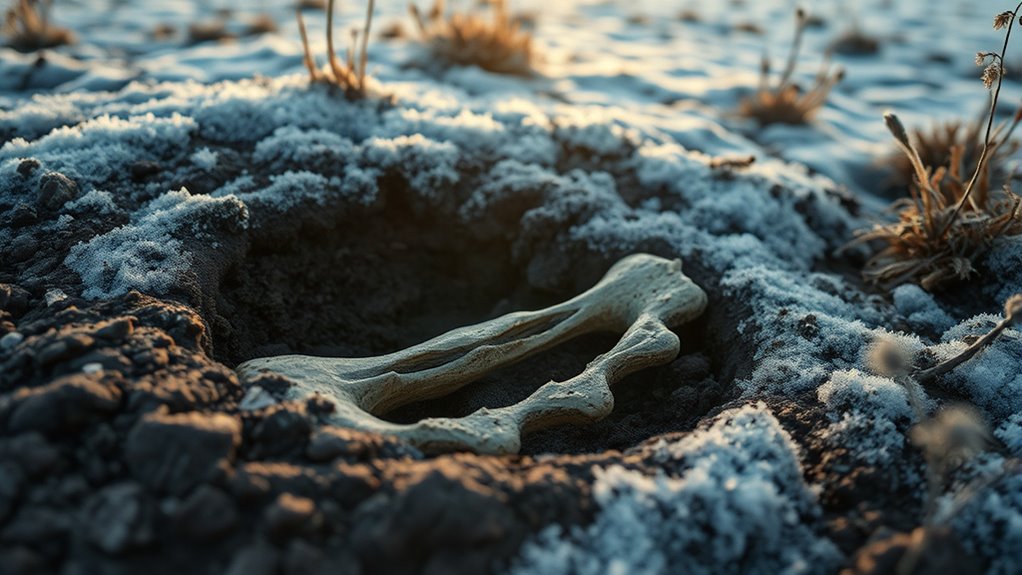Discovering ancient DNA from Siberia shows that human history there is far more complex than once thought. You’ll find evidence of diverse ancestral lineages and multiple interbreeding events with Neanderthals, shaping modern populations. This research reveals how early humans adapted to extreme environments through genetic exchange. It transforms our understanding of migration and interconnection across Eurasia. Keep exploring to learn how these findings unravel the intricate web of human evolution and migration patterns.
Key Takeaways
- Ancient Siberian DNA uncovers complex migration patterns and diverse ancestral lineages previously unrecognized.
- Evidence shows multiple interbreeding events between early humans and Neanderthals in Siberia.
- Genetic analysis reveals adaptive traits acquired through archaic human interactions, shaping modern populations.
- Findings refine understanding of human migration routes across Eurasia and early adaptation to extreme environments.
- Siberian ancient DNA highlights the significant role of local archaic human interactions in human evolutionary history.

Ancient DNA from Siberia is transforming our understanding of human history in this vast region. Recent discoveries reveal complex migration patterns that challenge previous models of human movement and interaction. By analyzing genetic material from ancient Siberian remains, scientists are uncovering evidence of diverse ancestral lineages and interbreeding events that shaped modern populations. One of the most intriguing findings involves Neanderthal admixture, which indicates that our ancestors interbred with Neanderthals more frequently and in different ways than previously thought. This admixture is not just a minor detail; it plays a significant role in how early humans adapted to Siberia’s extreme environment. Genetic diversity in these populations highlights the importance of interbreeding with archaic humans in shaping adaptive traits. When you look at the genetic data, you see that populations in Siberia carry a notable Neanderthal signature. This suggests that interbreeding happened early and possibly multiple times as humans migrated eastward across Eurasia. These interactions are vital because they contributed to genetic diversity, influencing traits like immune responses and skin pigmentation. The presence of Neanderthal DNA in Siberian populations helps pinpoint when and where these encounters took place, revealing a more intricate web of human-Neanderthal relationships than the simple one-time event once believed. It indicates that early humans didn’t just pass through Siberia but interacted with local archaic populations, potentially acquiring beneficial traits that helped them survive harsh climates. Understanding these interbreeding events sheds light on the adaptive evolution of early humans in extreme environments. Additionally, advances in ancient DNA analysis techniques continue to refine our understanding of these complex interactions and migration histories. Moreover, studying the migration routes through genetic markers can provide insights into how populations adapted to diverse environments across Eurasia. These findings underscore the importance of biodiversity in human evolutionary history, revealing how genetic variation contributed to survival and adaptation.
Frequently Asked Questions
How Does Ancient Siberian DNA Influence Current Population Genetics?
You can see that ancient Siberian DNA influences current population genetics by revealing diverse genetic lineages. This ancient genetic data shows migration patterns that shaped modern populations, increasing overall genetic diversity. By understanding these patterns, you gain insight into how human groups migrated and mixed over time, contributing to the rich genetic tapestry you see today. This knowledge helps explain the complex ancestry and variation present in populations across the globe.
Were There Any Extinct Human Species Discovered in Siberian DNA?
Like uncovering hidden treasures, ancient Siberian DNA reveals extinct human species. You find evidence of Neanderthal interactions and a Denisovan legacy, showing these groups once thrived in the region. These discoveries confirm that Siberia was home to more than just modern humans, with fossils and DNA pointing to extinct species that interbred with our ancestors. It’s a fascinating glimpse into a complex human past long buried in Siberian ice.
What Tools Are Used to Analyze Ancient DNA From Siberia?
You use advanced tools like DNA extraction methods to carefully isolate ancient DNA from Siberian samples. Sequencing technologies then read this fragile genetic material, allowing you to reconstruct genomes accurately. These tools help you analyze tiny, degraded fragments, revealing insights into ancient human populations. With precise extraction and high-throughput sequencing, you can uncover previously unknown ancestries and better understand human history from Siberian ancient DNA.
How Old Are the Oldest Siberian Human Remains With DNA?
You might find that the oldest Siberian human remains with DNA date back around 45,000 years. These ancient remains help you understand early migration patterns and cultural exchanges between groups. By analyzing this DNA, you can see how early humans moved across Siberia, influencing neighboring regions and shaping human history. Such discoveries shed light on the complex journeys that led to the diverse populations we see today.
Can Siberian Ancient DNA Help Understand Climate Adaptation?
Think of Siberian ancient DNA as a time capsule revealing humanity’s battle with the environment. By studying these genetic blueprints, you can uncover clues about climate resilience and environmental adaptation. This DNA acts like a map, showing how early humans adjusted to harsh conditions, helping you understand the genetic tools that fostered survival. It’s a powerful key to accessing how humans thrived amid changing climates across millennia.
Conclusion
So, after all this, it’s almost poetic—you set out to discover ancient Siberian DNA, only to find that your ancestors had more surprises up their sleeves than you ever imagined. Ironically, the more we learn about our past, the more mysterious it becomes. You’d think we’d have it all figured out by now, but instead, each discovery reminds you how little you truly know. Guess history still has a few secrets left, waiting to be uncovered.









